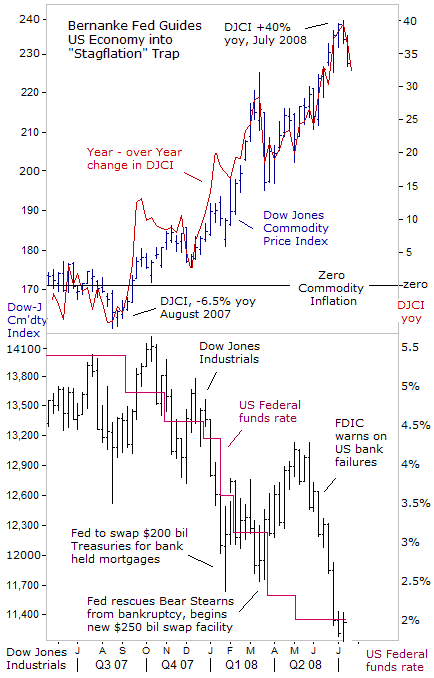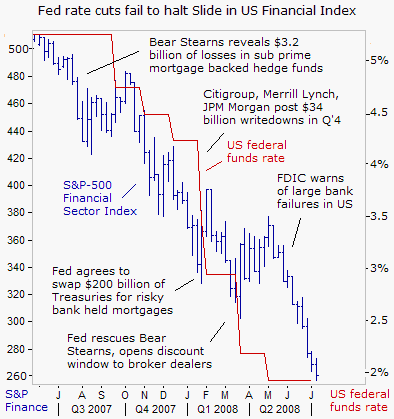|
|||
"Stagflation" Haunts Global Stock Markets, buoys GoldGary Dorsch In today's lightning fast and violent markets, where a constant barrage of news and noise flows into the marketplace each day, it's easy to forget a vital piece of information that was released just a few hours or days earlier. Trader sentiment is often swayed by the price action of the moment, and it's easy to lose sight of the core issues and mega-trends, that move the markets over the longer-term. It was nearly one-year ago, on July 17, 2007, when Bear Stearns BSC said in a letter to investors, that two of its troubled hedge funds that bet heavily on risky sub-prime mortgages had very little value. "The preliminary estimates show there is effectively no value left for the investors in the Enhanced Leverage Fund and very little value left for the investors in the High-Grade Fund, as of June 30, 2007," BSC said. BSC said the net asset value for the High-Grade Structured Credit Strategies Fund was about 9-cents on the dollar. Bear Stearns Asset Management said it would "seek an orderly wind-down of the funds over time. This is a difficult development for investors in these funds and it is certainly uncharacteristic of BSAM's overall strong record of performance. The losses reflected unprecedented declines in the valuations of a number of highly-rated AA and AAA securities," the letter said. At the time few traders could envision the chain of events that would follow from that letter. But since the $1.6 trillion US sub-prime mortgage crisis began to appear on investors' radar screens, about $11 trillion of wealth has evaporated from the global stock markets. Global banks and brokers have been forced to recognize $420 billion of losses from investments in the sub-prime mortgage market, and the IMF projects total losses to ultimately reach $1 trillion. Major stock market indexes around the world just wrapped up their worst first half in six-years. The Dow Jones Industrials lost 14.5% in the six-months through June 30, its worst start to a year in four-decades.The Euro-Stoxx-50 Index, a top gauge of the 15-nation Euro-zone, lost 24 percent. Shanghai red-chips plunged 48%, the worst half-year since 1992, and India's Sensex Index lost 38 percent. That's left the MSCI All World Stock Market Index entering into bear market territory, for the first time since the dot-com bubble burst at the beginning of the decade.
Besides the biggest banking crisis since the Great Depression, global stock market are also haunted by the ghost of "Stagflation," - a stagnant economy plagued by high and rising inflation, rearing its ugly head for the first time in three decades. "Stagflation," is a toxic witching brew for the global economy. A historic commodity boom has doubled agricultural and energy prices, while wage gains are lagging far behind. Factory profit margins are squeezed by soaring energy, raw material, and transportation costs. Trade balances are worsening in oil importing nations. "Stagflation" was last seen in the 1970's, when high oil prices fueled double-digit inflation. Back then, every time the Fed lowered interest rates to boost job growth, inflation took off, causing a vicious price spiral. On April 9th, former Fed chief Paul Volcker, said the present climate reminded him of the early 1970's. Then as now, certain commodity prices were rising fast, - he cited crude oil and soybeans as two examples. Then as now, these were explained away by government officials as speculative price run-ups and not as a harbinger of a big inflationary trend. The Fed let inflation rage for so long, that Volcker pursued a policy of targeting the money supply in 1979-82, in order to rein-in a 14% inflation rate. However, the cost of bottling-up the inflation genie was a deep recession, with unemployment hitting 11% in 1982. With commodity prices spiking again - soybeans are $16 a bushel today compared to $7 a year ago, crude oil at $135 /barrel compared with $70, Mr. Volcker warned US Treasury chief Henry Paulson, and Fed chief Ben Bernanke against letting inflationary expectations become embedded once again. "There must be a forceful response to confront the danger that inflation expectations could rise appreciably, with all the attendant problems that would bring," said BIS chief Malcolm Knight on June 24th. "With inflation a clear and present threat, and with real policy rates in most countries low by historical standards, a global bias towards monetary tightening would seem appropriate, even though economic growth is likely to be hit harder than most observers expect," the BIS said.
So far, the Fed and US Treasury have ignored Volcker's advice, and instead, are pegging the fed funds rate at -2.25% below the inflation rate, while inflating the MZM Money supply at a +16.5% annualized rate, a prescription for hyper-inflation. Yet the Fed's aggressive rate cuts have failed to stop the bleeding in the S&P Financial Sector Index, whichis off 50% from its 2007 record high. On July 9th, the S&P Financial Index fell 5.2% on the day, the biggest one-day percentage drop in six-years, led by Freddie Mac, which dropped 24% to $10.26, and Fannie Mae fell 13% to $15.31, to their lowest levels in 16-years. To read the rest of this article, click on the link below: http://www.sirchartsalot.com/article.php?id=90 Jul 8, 2008 |


